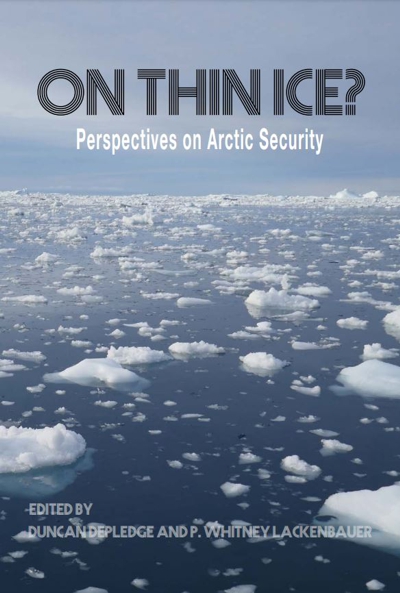Publication: On Thin Ice? Perspectives on Arctic Security
To download the publication please click on the download link at the bottom of the page
Edited by: Duncan Depledge and P. Whitney Lackenbauer
CNARC member: Fridtjof Nansen Institute (FNI)
Introduction: Around the world, politicians, civil servants, and military planners are waking up to the transformative effects that climate change will have on national and international security. The Arctic, which is warming at more than twice the average rate of the rest of the world, is at the epicentre of this challenge, with commentators frequently highlighting how the rapidly diminishing ice cover is transforming the geography and geopolitics of the region.
Many policymakers and publics still see Arctic climate change in deceptively simple terms, however. A popular narrative is that an increasingly ice-free Arctic Ocean (in summertime, at least) raises the prospect of shorter, faster shipping routes between the world’s largest trading economies. At the same time, greater maritime access is expected to facilitate the exploitation of vast troves of mineral and energy resources, as well as create new opportunities for fishing, bioprospecting, and tourism. Owing in part to the appeal of this story, when two submersibles planted a Russian flag on the seabed at the North Pole in 2007, there was worldwide alarm that the starting gun had been fired on an armed dash by Arctic states to seize new territory and assert exclusive access rights.
While the Arctic states1 correctly dismissed claims of impending armed conflict in the region (by both word and deed) and hyperbole alleging a new Arctic “gold rush,” the calm that has settled over the region is an uneasy one. Within and beyond the Arctic, questions remain about whether all is as well in the Circumpolar North as the Arctic states’ foreign ministries like to suggest. The intensity of regional military activity has risen, especially in the European High North, as tensions between NATO (North Atlantic Treaty Organization) allies and Russia have heightened in other parts of the world. Indeed, it did not take the Trump administration (2016-2020) long to expose the fragility of the so-called “Arctic exceptionalism”2 by declaring the Arctic “an arena of great power competition” and adopting a more confrontational posture towards Russia and China. While the Trump administration lacked subtlety, its approach did contain three kernels of truth:
- that Russia’s military posture in the Arctic is not easily disassociated from its attempts to divide, destabilize, and ultimately diminish the West;
- that China’s science- and commercially-led push for influence in the Arctic, most recognizably in Greenland and Iceland, raises important questions about the compatibility of Beijing’s long-term aspirations with the regional status quo; and
- that for decades, Western policymakers have under-invested in securing – in the broadest sense of the word – the Arctic and those who live there, leaving a void for potential competitors to exploit.
These kernels of truth have formed the basis of recent discussions about what a changing Arctic means for national defence and international security planning, and are readily apparent in the recent pronouncements and strategies of Western Arctic states, as well as public inquiries such as the one conducted by the United Kingdom’s House of Commons Defence Committee between 2017 and 2018.3 Instead of worrying about an ungoverned race for resources and territory in the Arctic, the emerging narrative locates a more significant concern, for Western security and defence communities, in the intensifying competition for global influence, and its effects on the Arctic. As geographers Klaus Dodds and Mark Nuttall have argued, the real “scramble” underway in the Arctic is for the authority to determine the region’s future, both in terms of who the principal actors are and what they are able to do there.4 The challenge for policymakers and other actors is to decide how best to monitor, respond, and intervene in this context.
The chapters in this volume echo other scholars in emphasizing that there is a robust array of rules, norms, and institutions that guide international interactions in the Circumpolar North. This rules-based order not only advances the Arctic states’ national interests but their global ones as well, offering opportunities to shape international agendas on climate change, contaminants, and other global environmental threats that have a disproportionate impact on the Arctic. Furthermore, the Arctic states continue to leverage existing multilateral organizations – such as the Arctic Council, Arctic Economic Council, United Nations Commission on the Limits of the Continental Shelf, International Maritime Organization (IMO), North Atlantic Treaty Organization (NATO), Arctic Coast Guard Forum, and Arctic “5+5” dialogue on Central Arctic Ocean fisheries – to promote their interests in the circumpolar world.5 These multilateral tools have proven resilient even with the downturn in relations between the West and Russia since 2014, with complex interdependence sustaining regional cooperation on search and rescue, transboundary fisheries, extended continental shelves, navigation, a mandatory polar code, and science.6 While these successes should be celebrated, this volume also reminds us that cooperative endeavours in the Arctic must be nurtured and sustained if the region is to remain peaceful. (to read more please go to the download link)
Article pointed out by FNI: A Governance and Risk Inventory for a Changing Arctic pp. 12-22


